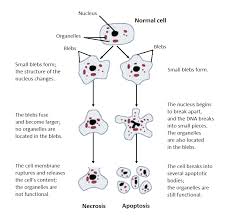necrosis
英 [ˈnek.rəʊ.sɪs]
美 [neˈkroʊ.sɪs]
- n. 坏死;坏疽;骨疽
星级词汇:

记忆方法
将“necrosis”分解为“ne”和“crosis”。想象“ne”是一个暗示,它是希腊语前缀,代表“不”或“非”,而“crosis”听起来像是“腐蚀”或“破坏”。组合起来,记忆为“不生机的腐蚀”,即细胞或组织死亡的过程。
以上内容由AI生成, 仅供参考和借鉴
中文词源
necrosis 器官或组织细胞坏死
necro-,死亡,-osis,症状。
英语词源
- necrosis (n.)
- "death of bodily tissue," 1660s, from Greek nekrosis "a becoming dead, state of death," from nekroun "make dead," from nekros "dead body" (see necro-). Related: Necrotic.
权威例句
- 1. Objective To investigate the effective methods in treating acute retinal necrosis ( ARN ).
- 目的探讨急性视网膜坏死 ( acuteretinal necrosis,ARN ) 的有效治疗方法.
- 2. Objective To discuss the clinical therapy of acute retinal necrosis syndrome ( ARN ) through summary of 5 cases.
- 目的 通过5例病例总结,探讨手术治疗急性视网膜坏死综合征 ( acuteretinal necrosis,ARN ) 的临床效果.
- 3. Areas of necrosis and cavitation may occur within the tumor.
- 肿瘤内可以有坏死和成腔区.
- 4. Confirmation can be obtained by detecting extensive necrosis through careful digital palpation.
- 通过仔细的手指触诊,能从检查出的广泛坏死而获得确诊.
- 5. Massive cortical necrosis can result in permanent anuria.
- 广泛的皮质坏死能造成永久性无尿.